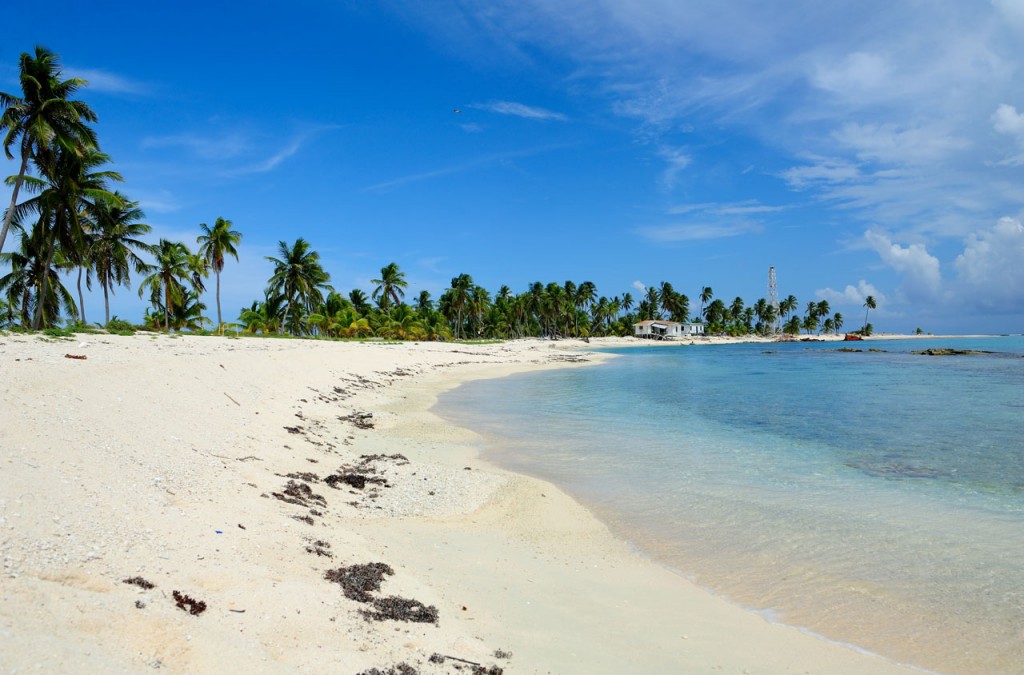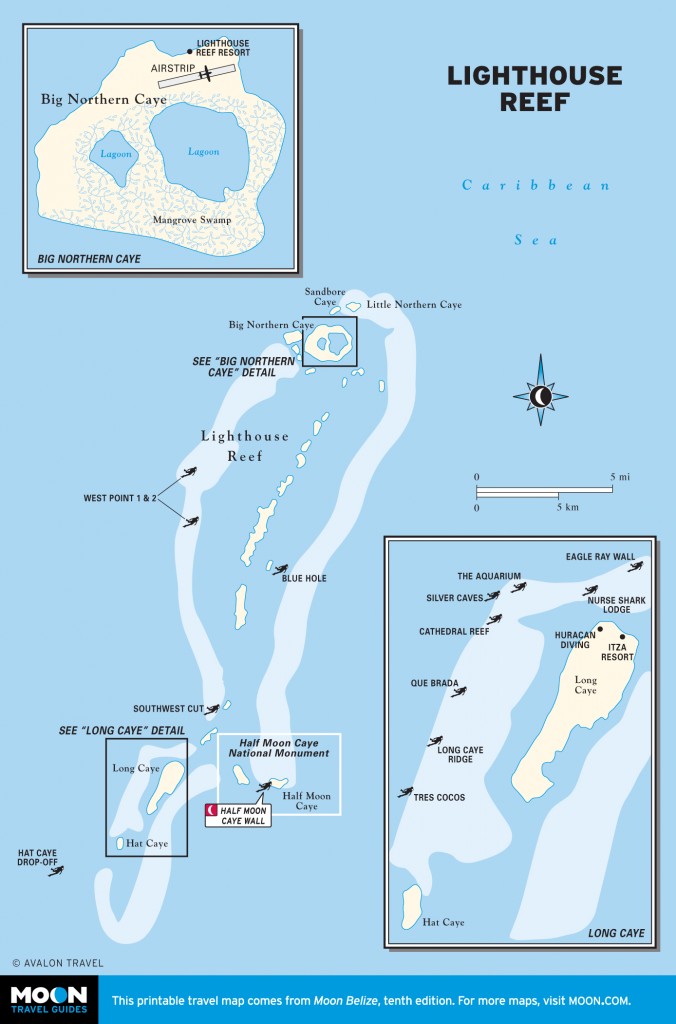The most easterly of Belize’s three atolls, Lighthouse Reef lies 50 miles southeast of Belize City. The 30-mile-long, 8-mile-wide lagoon is the location of the Blue Hole, a dive spot that was made famous by Jacques Cousteau and a favorite destination of dive boats from Belize City, Ambergris Caye, and Caye Caulker. The best dive spots, however, are along the walls of Half Moon Caye and Long Caye, where the diving rivals that of any in the world.

Beach on Half Moon Caye, Lighthouse Reef Atoll. Photo © Lebawit Lily Girma.
At the elbow of the handle is Half Moon Caye, a historical natural monument and protected area with its lighthouse, bird sanctuary, shipwrecks, and incredible diving offshore.Think of the atoll as a large spatula with a short handle and a long blade. At the northern tip of the spatula blade, Sandbore Caye is home to a rusty lighthouse and a few fishing shacks. It is also the favorite anchorage of several of the dive boats that do overnight stops, including Reef Roamer II.Big Northern Caye, across a narrow strait, has a landing strip that used to serve the now-closed resort here. There are long stretches of beach to walk, beautiful vistas, mangroves, and lagoons, home to snowy egrets and crocodiles. Halfway down the spatula-shaped atoll, about where the blade meets the handle, lies the magnificent Blue Hole, a formation best appreciated from the air, but also impressive from the bridge of a boat.
At the elbow of the handle is Half Moon Caye, a historical natural monument and protected area with its lighthouse, bird sanctuary, shipwrecks, and incredible diving offshore. Finally, on the handle, is Long Caye, a lonely outpost with a small dock, large palms, and glassy water.
This circular underwater formation, with its magnificent blue-to-black hues surrounded by neon water, is emblematic of Belize itself. The submerged shaft is a karst-eroded sinkhole with depths exceeding 400 feet. In the early 1970s, Jacques Cousteau and his crew explored the tunnels, caverns, and stalactites here, angled by past earthquakes.

Lighthouse Reef
Most dive groups descend to a depth of about 135 feet. Technically, this is not a dive for novices or even intermediate divers, though many intermediate divers do it with a guide. It requires a rapid descent, a very short period at depth, and a careful ascent, requiring excellent buoyancy control. For a group of 10 or more, at least three dive masters should be present. The Blue Hole is everything it is hyped up to be; my own personal experience there was extraordinary, and I gasped at the sight of the gigantic formations, the infinite depth, and the Caribbean reef sharks that circled nearby. It’s akin to an out-of-body experience. The lip of the crater down to about 60-80 feet has the most life: fat midnight parrot fish, stingrays, angelfish, butterfly fish, and other small reef fish cluster around coral heads and outcroppings.
On the eastern side of Lighthouse Reef Atoll, the reef has a shallow shelf in about 15 feet of water where garden eels are plentiful. The sandy area broken with corals extends downward till you run into the reef wall, which rises some 20 feet toward the surface. Most boats anchor in the sandy area above the reef wall. Numerous fissures in the reef crest form canyons or tunnels leading out to the vertical face. In this area, sandy shelves and valleys frequently harbor nurse sharks and gigantic stingrays. Divers here are sure to return with a wealth of wonderful pictures.
Minutes from Half Moon Caye Wall, often combined with a Blue Hole trip, is a spectacular dive site ideal for photos and with the most marinelife spotting, even more than at Half Moon Caye Wall. The electrifying deep-blue waters will stun you, as will the schools of bright colorful fish and the large eagle rays, sea turtles, stingrays, and nurse sharks.
The shoals of silversides (small gleaming minnows) that gave this western atoll site its name are gone, but Silver Caves is still impressive and enjoyable. The coral formations are riddled with large crevices and caves that cut clear through the reef. As you enter the water above the sandy slope where most boats anchor, you’ll be in about 30 feet of water and surrounded by friendly yellowtail snappers. Once again you’ll see the downwardly sloping bottom, the rising reef crest, and the stomach-flipping drop into the blue.
On the western wall, “Three Coconuts” refers to trees on nearby Long Caye. The sandy bottom slopes from about 30 feet to about 40 feet deep before it plunges downward. Overhangs are common features here, and sponges and soft corals adorn the walls. Another fish lover’s paradise, Tres Cocos does not have the outstanding coral formations you’ll see at several other dives in the area, but who cares? There’s a rainbow of marinelife all about. Turtles, morays, jacks, coral, shrimp, cowfish, rays, and angelfish are among the actors on this colorful stage.
Farther north and about even with the Blue Hole, West Point is well worth a dive. Visibility may be a bit more limited than down south, but it’s still very acceptable. The reef face here is stepped. The first drop plunges from about 30 feet to well over 100 feet deep. Another coral and sand slope at that depth extends a short distance before dropping vertically into very deep water. The first shallow wall has pronounced overhangs and lush coral and sponge growth.
Excerpted from the First Edition of Moon Belize Cayes.